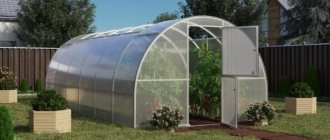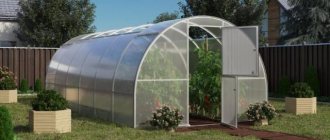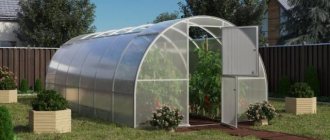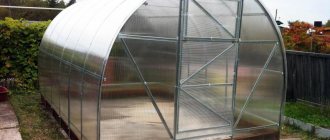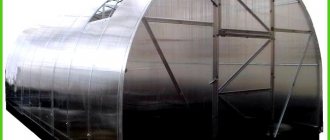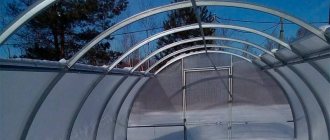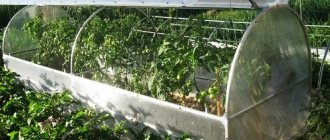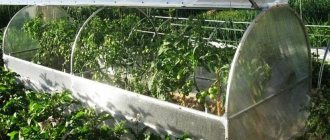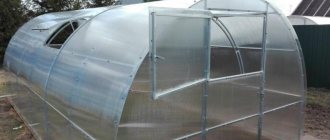Traditional greenhouses with closed sides, making it difficult to approach plants, and welded prefabricated arches, reducing resistance to loads, are being replaced by more reliable structures. Summer residents prefer durable products. The Tulip greenhouse with an opening roof and sides does not collapse under the weight of snow, allows you to conveniently approach the plants and get a rich harvest.
Features of the Tulip greenhouse
The new design of the Tulip greenhouse with a sliding roof and sides has a number of advantages along with the traditional ones:
- reinforced “anti-storm” guide arc system;
- simplified assembly using a four-bolt “crab” system;
- reliable frame made of all-welded arcs;
- Attached is a video instruction for assembling the Tulip greenhouse;
- sheets do not stick when condensation accumulates;
- the opening mechanism of the roof and sides is equipped with rubber seals;
- polycarbonate is mounted in guide arcs;
- no foundation required;
- the opening roof and sides are resistant to wind and snow loads;
- Warranty period up to 15 years.
What is a “Dachnik” greenhouse?
Gardeners often complain that it is physically impossible to install a greenhouse in a small area. To a certain extent, this is true, because most greenhouses require significant space. That is why the “Dachnik” model developed by Russian engineers is unique.
The assembly process will take no more than two hours, which will appeal to beginners in the world of gardening. In addition to this, one more fact will bring happiness - the shape of the greenhouse allows it to be placed in the corner of the plot.
Simply put, a new house for seedlings will not “eat up” the already scarce square meters.
In addition, structures of this kind have several more advantages:
- The ability to quickly install an artificial lighting or irrigation system;
- There is additional reinforcement of the input group;
- The operating temperature range is from -10 to 25 degrees Celsius;
- Regardless of the strength of the wind, the side panels will withstand the elements;
- The slopes on the roof prevent precipitation from accumulating.
The “Dachnik” greenhouse provoked real joy. On the one hand, gardeners received a compact, lightweight and yet durable design. On the other hand, it is less demanding in terms of maintenance. This saves time and effort.
Advantages and disadvantages
Advantages of the Tulip greenhouse with opening top:
- galvanized solid-bent arches increase the reliability of the structure;
- the opening roof mechanism eliminates snow loads;
- natural microclimate increases productivity;
- the opening roof and sides allow the greenhouse to be watered with rain, which enriches the earth with minerals;
- the opening mechanism of the sides promotes natural air exchange - plants receive the necessary dose of oxygen every day without drafts;
- opening sides allow you to conveniently approach each plant;
- the opening top will help fill the greenhouse with snow, this protects the soil from freezing and preserves its microflora;
- the guides are made of galvanized profile and equipped with a rubber seal at the points of contact with polycarbonate;
- opening sides and roof promote natural pollination of crops;
- The warranty period has been extended to 15 years.
Flaws:
- when installed without a foundation, severe distortion of the structure is possible;
- it is difficult to mount the opening element of the sides and roof to the arches;
- plastic parts lose elasticity in the cold, forming gaps between the frame and the guides of the opening mechanism;
- the manufacturer is located in Belarus, which complicates the supply of spare parts, since Russian distributors do not sell them;
- The crab system becomes loose during operation.
Advantages
A fairly large number of types of greenhouses are produced in Russia, each of which finds its own consumer.
A wide variety of models are offered:
- glass, polyethylene and polycarbonate;
- frames made of all-welded steel pipes and similar ones made of collapsible ones; the frame is made of plastic, wood or metal;
- equipped with windows (most models), opening (“Delta”) or sliding doors (“Tulip”, “Botanist”);
- with a removable ("Convertible"), sliding to the ends ("Matryoshka"), sliding ("Botanist") or opening roof ("Umnitsa").
As for the “Tulip” greenhouse, this is a product patented in the Russian Federation and the Republic of Belarus. This type belongs to the new products of 2022, that is, a completely “fresh” design. Like any other thing, the Tulip greenhouse has both advantages and disadvantages.
The undoubted advantages include several characteristics.
- No snow load. The roof of the greenhouse can be easily moved during cold periods, which will prevent it from being damaged by the weight.
- Since the snow will fall directly into the greenhouse, it will cover the soil and prevent it from freezing. This, in turn, will allow the preservation of favorable soil microflora, which will have a positive effect on the growth and development of crops in spring and summer.
- The use of this type of greenhouse helps create a natural microclimate for plants, which leads to increased productivity.
- Ensure proper ventilation thanks to sliding roof sashes.
- Possibility of natural watering. If you move the roof flaps apart, natural irrigation will occur during rain.
- Polycarbonate is considered one of the most durable and easy-to-use materials.
- Ease of use due to design features. With careful use, the service life will be more than 10 years.
This type of greenhouse also has its disadvantages.
- The rapid loss of appearance of polycarbonate and its wear and tear compared to glass greenhouses, as well as the expensive replacement of failed areas.
- Supporters of traditional greenhouse designs do not approve of replacing the vents with sliding sides and moving them to the doors.
- There is also an inconvenience that polycarbonate is not included in the greenhouse kit and must be ordered separately. True, some summer residents, on the contrary, are happy about this, since you can choose the density of polycarbonate to your liking. Manufacturers explain the need to separately purchase polycarbonate by the fact that there is currently no representative office of the company in Russia, and supplies from Belarus are expensive and unreliable in terms of the possibility of damage to the material.
- The main disadvantage of this type is its price, which varies from 25,000 rubles. up to 46,000 rubles, which can be quite a significant amount for most gardeners.
If we compare the “Tulip” with the “Delta” greenhouse, which at first glance has a similar type of device, we can highlight the main difference: in the first version the roof and sides move, and in the second they rise. Accordingly, “Delta” and other similar structures require additional space when its doors are open. This is not required for Tulip.
What can be grown in a Tulip greenhouse
One of the advantages of greenhouses with opening tops and sides is their versatility. Such greenhouses are perfect for growing fruits, vegetables and flowers. Often, a greenhouse is used to force tulips in early spring.
The structure is suitable for breeders. The innovative design allows you to freely approach plants and carry out the necessary experiments on them.
Design characteristics
New for 2022, the Tulip greenhouse with opening sides and a sliding roof is made from a closed galvanized pipe 40*20 mm. The ends of the structure are equipped with wide doors with built-in windows. A 1 m wide door connector allows you to bring a wheelbarrow into the greenhouse.
Important! The arcs are made of all-welded pipe. This increases the rigidity and stability of the structure.
Dimensions
The manufacturer produces a product with a width of 3 m, a height of 2.1 m, and a length of 4, 6, 8, 10 m. The length of the greenhouse can be increased at the customer’s request in increments of 2 m.
The opening side element allows free access to plants from all sides, so it can be installed closely between beds.
The size of the Tulip mini-greenhouse with opening sides is 2000*1100*1000 mm. At the request of the summer resident, the mini greenhouse can be equipped with a galvanized bed, in which case its height will increase by 200 mm. The modular system allows you to increase the length to 4, 6, 8, 10 m, in multiples of 2 m.
Materials
The frame of the greenhouse is made of galvanized pipes with a cross section of 40*20 mm. The innovative four-bolt crab fasteners are made from UV-resistant plastic or galvanized iron. If you have a choice, it is better to choose iron elements.
The roof is covered with Standard or reinforced Premium polycarbonate with a UV filter. The guides are made of profile and plastic with a UV filter and sealing rubber bands along the contour.
Equipment
The polycarbonate greenhouse set Tulip is equipped with:
- supports;
- guides that open the sides and roof;
- arcs;
- installation diagram;
- polycarbonate;
- bolts, hardware, self-tapping screws and screws;
- crab fasteners.
Choosing a location for installation
The manufacturer guarantees that the greenhouse can be installed on any flat area. However, the structure is a reinforced structure, so assembly experts recommend building a foundation. It will be enough to build a log base from 100*100 mm timber.
The site on which the structure will be located must be in an open, sunny and windless place. A hard and level soil surface will protect the greenhouse from distortions.
The location of the greenhouse close to the house or barn will increase ease of use. Since there is always a need to carry buckets, boxes, and a fertilizer sprayer into it. But it is also necessary to take into account the proximity of the water supply point.
If the size of the plot allows you to squeeze the greenhouse only between the beds, you should leave space under the path for convenient passage.
The initial stage of installing the “Dachnik” greenhouse
Properly performed excavation work will ensure long-term operation of the building. The design features of the greenhouse require that all work be performed strictly in one plane. After this, the drawn up plan is taken into hand, on the basis of which the territory is marked out.
This is done with the obligatory measurement of the distance between all installed stakes. If the results indicate that the preparatory installation was correct, you can safely move on to the next stage.
Regardless of the type of material from which the support stakes are made, they go to a depth of 35 to 45 cm. It is enough to reduce this indicator by a couple of cm to worsen the strength of the “Dachnik” greenhouse.
In addition, it would be a good idea to pay attention to the tips below:
- The minimum height of pegs above ground level is 10 cm;
- The permissible distance between supporting elements ranges from 5 to 10 mm;
- The permissible deviation of the peg installation points from the applied dimension line has a similar meaning;
- The length of the diagonals (A) and the selected perimeter (B) are measured - the result obtained should not exceed 13 mm.
Despite its apparent simplicity, the preparatory stage requires maximum pedantry. The more accurately the perimeter and support stakes are set, the fewer problems will arise when installing the sections.
Assembling the Tulip greenhouse
To assemble the greenhouse, you will need the following set of tools:
- screwdriver with a cross and an 8 mm hexagon;
- 10 mm wrench;
- construction knife with a retractable blade;
- roulette;
- level.
It is recommended to install the Tulip greenhouse wearing cotton gloves with anti-slip rubber coating. In the selected area, it is necessary to level the ground and, if necessary, cover it with geotextile fabric.
Attention! Geotextiles are used on eroded and loose soils to strengthen the soil surface. It has drainage and reinforcing properties.
If the owner decides to build a foundation for the greenhouse, it is necessary to lay a beam measuring 10 * 10 m according to the dimensions of the greenhouse on a flat, prepared surface.
The set is equipped with lugs. If the foundation is not being constructed, it is necessary to install these supports around the perimeter. The lugs are leveled to avoid further distortion of the Tulip polycarbonate greenhouse.
The base is mounted level on the lugs or foundation. Using the “crab system” all elements of the structure are secured.
After installing the base, it is necessary to check the level of the future greenhouse diagonally. Arcs are attached to the base in 1 m increments.
The ends are sheathed with polycarbonate. The remaining material is cut end to end with a construction knife with a retractable blade.
The ends are installed on the base.
The arches installed on the base are securely fixed with guides using the Crab system. This element gives stability and rigidity to the structure.
The erected structure is checked by level.
Polycarbonate is cut out according to the dimensions of the sidewalls and roof elements.
Guides for the opening system are attached to the arches.
The covering material is tightened into the grooves for polycarbonate and a rubber seal is laid.
Window windows are installed.
Strengthen the connecting elements of the retractable polycarbonate structure with forks.
Check the operation of the installed greenhouse elements.
How to assemble a Tulip greenhouse on video:
Greenhouse "Botanist": user reviews
Looking through the Internet pages, you can see that many people leave their reviews under products from the category of greenhouse structures. From what was discovered, we can conclude that the majority of forum users are satisfied with the quality of the greenhouse, its performance and appearance.
The Botanik greenhouse, reviews of which are mostly positive, is in demand and has a good reputation.
The disadvantages are all attributed to just one single factor - the high price of the product. But this is not surprising. The structure is so well equipped both outside and inside that it simply cannot cost little money.
From the reviews you can note the following:
- The greenhouse meets all the necessary requirements and produces an excellent harvest;
- Thanks to a well-thought-out design, the building is not afraid of strong winds and severe frosts;
- The company’s employees carefully study all the customer’s wishes and strive to produce a design that best meets his requirements;
- It is not at all necessary to build a foundation for the greenhouse, since the structure itself is strong.
- You should not order such a design with polypropylene sheathing. Its price will not be much less, but the quality will be almost half as bad.
Some disadvantages include the bulkiness of the design. It is not suitable for those who want to have a small, modest greenhouse on their estate.
How does it differ from analogues
The differences between the Tulip greenhouse and similar greenhouses are presented in the table:
| Regular greenhouse | Greenhouse Tulip |
| Collapsible arches are susceptible to destruction in winter and in very windy weather. The structure is unstable. | Solid bent arches increase the rigidity of the structure. Increases stability. |
| Products are made from profiles with a cross section of 20*20 mm. The thin pipe cannot withstand harsh weather conditions. | The production uses galvanized all-welded pipe with a cross-section of 20*40 mm. This increases the reliability of the structure under loads. |
| Cheap H-shaped guides made of plastic cannot cope with the load. In winter, when exposed to snow, polycarbonate swells and is squeezed out. | The innovative guide system is equipped with a rubber seal. This improves the ergonomic properties of the design. |
| Complex assembly. Lots of fasteners. | Welded parts greatly simplify the installation of the greenhouse. The greenhouse remains to be assembled like a construction set. |
| An open roof does not provide adequate ventilation. When the door and roof are open, a draft occurs, which reduces the immunity of plants. The sides are equipped with expensive windows. There is no opening mechanism. | The sliding system raises the sides and lowers the roof, which allows you to ventilate the greenhouse in 2 minutes in natural conditions without drafts. There is an opening mechanism. |
Tips for use
The performance indicators of the Tulip greenhouse are characterized by increased reliability to weather conditions. However, any product loses its performance over time during use. In order for the structure to last longer, it is necessary to carry out seasonal inspection of the structure in the fall after harvesting and in the spring after wintering.
Warning! In the fall, it is necessary to turn off the water to the drip irrigation system so that the pipes do not burst due to frost. If water is supplied from a plastic barrel, it must be brought into a barn or other utility room.
When inspecting the structure, you should pay attention to the crab fasteners. Bolts and screws must securely and firmly fix the structure. If the connecting unit is loose and the elements become loose, the bolts must be tightened and, if necessary, replaced.
The guidance system of the retractable roof and sides of the Tulip greenhouse requires seasonal inspection. After winter weather, sudden temperature changes can cause the rubber seal to crack. If this happens, it must be replaced.
Proper preparation of a greenhouse for winter: tips from summer residents
The winter period is a time of increased attention of the gardener to the greenhouse. The more accurately the preparation is carried out for the subsequent operation of the structure in the cold, the greater the chances of getting a good harvest in the coming year. If the greenhouse is used only for a few months a year, then it is better to store the collapsible frame in a closet until spring. In the case where the building is used year-round, you need to devote time to preparing it for winter.
Based on numerous reviews from summer residents, recommendations were made to properly prepare the greenhouse for winter:
- Remove even the slightest remnants of existing green spaces;
- Remove 7 to 9 cm of topsoil;
- Dig up all remaining soil for debris and pests;
- During cold weather, it is better to remove the polycarbonate layer, otherwise the nutrients in the soil will die;
- Treat the external and internal walls of the greenhouse with a solution that kills pests and all kinds of diseases of flora;
- Treat garden tools with bleach;
- Carry out fumigation of the internal space of the building.
A common mistake is to believe in nature's benevolence. Even in temperate climates frosts of -20 to -30 degrees Celsius occur. In this regard, you should not neglect the advice given. A similar requirement is true when it comes to assembling a greenhouse in the spring.
Photos of greenhouses
The photo shows a Tulip polycarbonate greenhouse from the inside:
You can see how the sides of the floors open and the roof goes down.
In winter, the roof opens and the greenhouse fills with snow.
The wide doors are equipped with a window.
The greenhouse used Premium reinforced polycarbonate with a UV filter.
Greenhouse ventilation option.
The innovative design allows you to equip a swimming pool in the greenhouse.
Portable mini-greenhouse Tulip with a bed made of galvanized iron, opening sides and roof.
Greenhouse "Botanik": advantages and disadvantages
When developing new models of greenhouses and greenhouses, their manufacturers try to take into account all the shortcomings of previous designs and the wishes of users. For example, buildings made from profiled steel pipes are highly susceptible to corrosion. In view of this, galvanized steel is used in Botanik greenhouses.
The “Botanik” greenhouse is the newest of all designs existing on the market. For a more attractive appearance, greenhouses have a multi-colored frame.
Typically this greenhouse has two types of roof: gable and arched. It must be said right away that the gable roof is considered more aesthetic, while the arched structure has proven its practicality, tightness and streamlining.
Advantages of the Botanik greenhouse:
- Strength of the structure;
- Aesthetic appearance;
- Excellent light transmission ability;
- Adjustable sizes;
- Modern protection and ventilation systems;
- Easy to install;
- It has a strong foundation, in the presence of which there is no need to build a foundation for the building;
- There is the possibility of equipping modern heating and irrigation systems;
- When manufacturing the structure, a new glass fastening system is used, which makes it possible to make the greenhouse more hermetically glazed.
Also inside the structure there are devices for tying up plants, which makes the work of those who care for it much easier.
